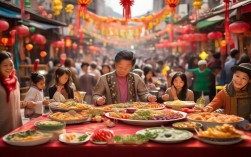Chinese New Year, also known as Spring Festival, is a time of celebration, family reunions, and, of course, delicious food. Each dish served during this festive season carries symbolic meaning, from prosperity to longevity. If you're learning English or simply want to share the richness of Chinese New Year cuisine with international friends, knowing the right food vocabulary is essential. Below is a comprehensive guide to the most important Chinese New Year dishes and their English translations, along with cultural significance.

Traditional Chinese New Year Dishes and Their Meanings
Dumplings (饺子 – Jiǎozi)
Dumplings are a must-eat during Chinese New Year, especially in northern China. Their shape resembles ancient Chinese gold ingots, symbolizing wealth and prosperity. Families often gather to make dumplings together, reinforcing bonds.
Key Vocabulary:
- Wrappers (饺子皮 – Jiǎozipí) – The thin dough used to encase the filling.
- Filling (馅儿 – Xiànr) – Usually made of minced pork, cabbage, or shrimp.
- Boiled dumplings (水饺 – Shuǐjiǎo)
- Pan-fried dumplings (煎饺 – Jiānjiǎo)
Spring Rolls (春卷 – Chūnjuǎn)
Crispy and golden, spring rolls represent wealth because their shape resembles gold bars. They are typically filled with vegetables, meat, or sweet bean paste.
Key Vocabulary:
- Deep-fried (油炸的 – Yóuzhá de)
- Vegetarian spring rolls (素春卷 – Sù chūnjuǎn)
Fish (鱼 – Yú)
A whole fish is served to symbolize abundance, as the Chinese word for fish (鱼 – yú) sounds like "surplus" (余 – yú). It’s customary to leave some leftovers to ensure prosperity for the coming year.
Key Vocabulary:

- Steamed fish (清蒸鱼 – Qīngzhēng yú)
- Braised fish (红烧鱼 – Hóngshāo yú)
- Sweet and sour fish (糖醋鱼 – Tángcù yú)
Nian Gao (年糕 – Niángāo)
This sticky rice cake symbolizes progress and growth because "niángāo" sounds like "higher year." It can be steamed, fried, or even used in sweet soups.
Key Vocabulary:
- Glutinous rice (糯米 – Nuòmǐ)
- Pan-fried nian gao (煎年糕 – Jiān niángāo)
Tangyuan (汤圆 – Tāngyuán)
These sweet glutinous rice balls, often eaten during the Lantern Festival, represent family unity due to their round shape.
Key Vocabulary:
- Sesame filling (芝麻馅 – Zhīma xiàn)
- Red bean filling (红豆馅 – Hóngdòu xiàn)
Longevity Noodles (长寿面 – Chángshòu miàn)
These uncut noodles symbolize a long life. The longer the noodle, the better—it’s bad luck to break them before eating!
Key Vocabulary:

- Stir-fried noodles (炒面 – Chǎomiàn)
- Soup noodles (汤面 – Tāngmiàn)
Eight Treasures Rice (八宝饭 – Bābǎo fàn)
A sweet dish made with glutinous rice, dried fruits, and nuts, representing good fortune and completeness.
Key Vocabulary:
- Red dates (红枣 – Hóngzǎo)
- Lotus seeds (莲子 – Liánzǐ)
Turnip Cake (萝卜糕 – Luóbogāo)
A savory Cantonese dish made from shredded radish and rice flour, symbolizing rising fortunes.
Key Vocabulary:
- Pan-fried turnip cake (煎萝卜糕 – Jiān luóbogāo)
Modern and Regional Variations
While traditional dishes dominate, modern and regional variations add diversity to Chinese New Year feasts:
- Hot Pot (火锅 – Huǒguō) – Popular in Sichuan and Chongqing, symbolizing warmth and togetherness.
- Jiaozi with unique fillings – Some families experiment with seafood or vegetarian options.
- Prosperity Toss (捞鱼生 – Lāo yúshēng) – A Singaporean and Malaysian tradition where diners toss shredded raw fish salad for luck.
How to Talk About Chinese New Year Food in English
If you’re explaining these dishes to English speakers, here are some useful phrases:

- "This dish symbolizes good luck and prosperity."
- "We eat this during New Year for a long and happy life."
- "Would you like to try some traditional Spring Festival food?"
Chinese New Year cuisine is more than just food—it’s a cultural experience. Whether you’re hosting foreign guests or simply expanding your English vocabulary, knowing these terms will help you share the joy of the festival.
The next time you sit down for a reunion dinner, you’ll not only savor the flavors but also appreciate the deep cultural meanings behind every bite.


